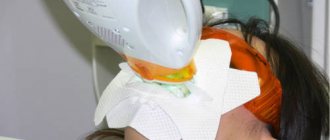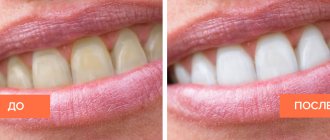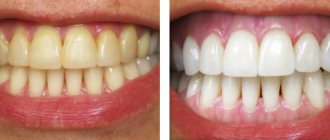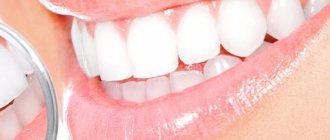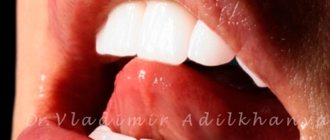From this article you will learn:
- types of professional and home whitening,
- which method is better and safer,
- teeth whitening in St. Petersburg and Moscow – prices 2022.
The article was written by a dentist with more than 19 years of experience.
Cosmetic teeth whitening can be professional, in which case it is performed in a dental clinic, or at home, using at-home products (for example, Crest whitening strips, Opalescense whitening gel, and special toothpastes).
As a dentist, I have to admit that home remedies for teeth whitening are becoming more effective every year. Already today, some of them allow you to achieve results that are quite comparable to the effectiveness of professional teeth whitening techniques - such as “Zoom”, “Beyond Polus”, “Opalescence Boost”, etc.
There is a lot of misinformation being circulated regarding professional and home whitening. For example, you will never be able to lighten your teeth by 8-12 shades - which is what they constantly say in advertising. The real result is 4-6 tones on the VITA scale (Fig. 2). And besides, whitening is not as safe for the hard tissues of teeth as they try to make it out to be.
In this article we will talk about the pros and cons of all the main methods of home and professional whitening, compare their cost and effectiveness. Below you can read reviews on teeth whitening, as well as see “before and after” photos of various whitening techniques.
How does teeth whitening work?
Both home and professional teeth whitening use the same principle of chemical whitening - through the use of peroxide compounds (hydrogen peroxide or carbamide peroxide). These substances, with prolonged contact with the surface of the teeth, are able to penetrate the entire depth of enamel and dentin. Penetrating into the tooth tissue, they gradually disintegrate with the release of free radicals, namely atomic oxygen (Fig. 3).
It is atomic oxygen that leads to the destruction of molecules of chromogenic substances (pigments), which give teeth a dark color. To make the whitening process more effective and safe, hydrogen peroxide or carbamide peroxide is used in the form of a highly concentrated gel.
In professional whitening products, a whitening gel is applied by the dentist to the front surfaces of the upper and lower teeth. In home whitening products, the whitening gel is usually pre-applied to the inner surface of whitening strips or special dental trays (which the patient will have to apply to the teeth for a while).
Evaluating the effectiveness of bleaching –
The effectiveness of whitening is assessed by comparing the shade of teeth before and after the whitening procedure. Most often, the “Vita” tooth shade scale is used for this (Fig. 2). We have already said above that the use of even the most effective whitening products allows you to lighten your teeth by an average of 4-6 shades (tones). Accordingly, in Fig. 5 you can see what difference can be achieved.
Teeth of different shades may respond differently to whitening. So, the whitening effect (before and after results) will be most noticeable if your teeth are yellowish. If you want to whiten teeth that are already quite light, the effect will be minimal - no more than 1-2 tones. As for teeth with gray and brownish shades, even professional teeth whitening in a clinic will be ineffective.
Why do you need whitening?
The indications for this procedure are more social than medical - eliminating such a deficiency as darkened teeth helps the patient feel more confident in society and, thereby, improve the quality of life.
More often, patients turn to a dentist for help to lighten their tooth enamel for the following reasons:
- age-related color changes;
- darkening of the tooth after visiting the endodontist (tooth removal);
- uneven enamel color (spots);
- “tetracycline” teeth - if in childhood they were “overfed” with antibiotics.
Teeth whitening: price 2022
So, how much does teeth whitening at the dentist cost, and how much cheaper will it be to do it at home... Below we will list the most effective home and professional teeth whitening - types and prices in Moscow and St. Petersburg for 2022, and further in the article we will analyze in detail the pros and cons of each type bleaching. Prices are indicated for mid-price clinics.
1) Professional whitening techniques –
- Zoom-4 – from 15,000 rub.
- Beyond Polus – from 10,000 rub.
- Opalescence Boost PF – from RUB 9,000.
2) Home whitening –
- whitening strips – from 2500 to 5500 rubles.
- whitening gel and Opalescense dental trays – from 4,300 rubles.
Important: in some clinics you may see prices significantly lower than those indicated by us (for example, Zoom costs 8,000 rubles). Only the cost of the original set of Zoom consumables for 1 patient is about 9,500 rubles (Fig. 5). Therefore, if you see prices for Zoom whitening in the range of 8,000 - 10,000 rubles, this will mean that the clinic will not use original materials, but analogs/counterfeits made in China.
Arguments for and against whitening
If you have no absolute contraindications to the procedure, and those that exist can be eliminated, it remains to determine whether the gamble is worth the candle in your case. To decide whether you need to do this, you should consider the pros and cons of whitening and evaluate the possible consequences and risks. If the result suits you, you can move on to further actions.
Pros of whitening:
- Helps improve your smile and appearance. This is exactly why people are ready for bold experiments.
- Increases self-confidence. If you know that you have the advantage of a charming smile, then you behave differently. And this inner confidence is transferred to others, which can radically change your communication.
- Helps you look younger and healthier. Youth and health are no less attractive than good looks. And together they can work wonders.
Cons of whitening:
- Unpleasant consequences for gums and teeth. Since the procedure uses powerful chemical agents such as hydrogen peroxide. They can have an irritating effect on the enamel of teeth and gums. Increased sensitivity of varying severity is an almost universal side effect.
- The need to adhere to a diet. To maintain the results of whitening, you will have to eliminate or significantly limit the consumption of highly coloring foods. Otherwise, red wine, berries and soy sauce will quickly ruin all your efforts.
- Regular actions to maintain whiteness. In addition to the usual care in the form of a brush, paste and floss, maintenance therapy is often required. This may include whitening pastes, trays or strips for home use.
Professional teeth whitening at the dentist –
Today there are 3 main types of professional whitening. The first two methods: photo whitening and laser teeth whitening imply that, in addition to the whitening gel, a special light source (laser or special whitening lamp) will also be used. The third method, when only whitening gel is used, is no less effective.
Today, the most popular in-office whitening methods are “Zoom” (Fig. 4-6) and “Beyond Polus”. These are photo teeth whitening techniques that involve the use of not only a gel with hydrogen peroxide during the procedure, but also a special whitening lamp. Such lamps do not have their own whitening effect and are designed to increase the rate of breakdown of hydrogen peroxide into free radicals.
Zoom-4 lamp and whitening kit –
Clinical teeth whitening at the dentist has undeniable advantages. First of all, it requires only 1 visit to the dentist, and the duration of the procedure takes only 1 hour - in contrast to the long daily use of home whitening systems for 10-20 days. In addition, the procedure itself takes place under the supervision of a dentist, which reduces the risk of side effects and increases the effectiveness of the procedure. But, in principle, this is where the advantages end.
In terms of effectiveness, the effectiveness of professional and home whitening systems is almost equal. This turned out to be possible thanks to the fact that many high-quality foreign manufacturers of dental materials, along with professional whitening systems for dentists, began to produce kits for home whitening - such as “Opalescense” and “Perfect Bleach”. They are produced by such well-known manufacturers of dental materials as ULTRADENT (USA) and VOCO (Germany).
Thus, in both home and professional systems, in principle, the same technologies are used. In addition, we must admit the following: statements by dentists that professional whitening leads to teeth lightening by 8-12 shades, and that the effect lasts for 3-5 years - all this has nothing to do with reality and is largely advertising. And that's why…
→ Reviews about the Zoom-4 whitening method
Teeth whitening before and after: photo
Below you can see what real results of professional whitening can be achieved (without editing before and after photos in Photoshop).
Significant disadvantages of professional whitening –
- The degree of whitening will be lower than expected - the dentist will measure the color of your teeth using a special Vita scale - before and immediately after the whitening procedure.
The problem is that teeth lose a lot of moisture during whitening, and overdried teeth always look whiter than they actually are. Therefore, the color that you see immediately after the procedure will only be temporary. Within 24-48 hours, when the hard tissues of the teeth are saturated with water contained in the oral fluid, the color of the teeth will become much darker than what the dentist will measure for you on the Vita scale. If your dentist persistently guarantees that your teeth will be brightened by 6 or 8 tones, then ask him to measure the color of your teeth not immediately after the procedure, but after 1-2 days, and ask him to include this clause in the contract for the possibility of a refund. Believe me, the dentist’s mood will immediately change... - Duration of the whitening effect - when they tell you that the whitening effect will last for several years - all this is not entirely true.
The fact is that there is a direct relationship: the shorter and more aggressive the whitening procedure, the faster the color will “rebound” back. That is why, after completing the in-office whitening procedure, the dentist will strongly recommend purchasing a home whitening system from their clinic (to maintain its results). Without this home whitening system, the color of your teeth will quickly return, and within 3-5 months the effect will no longer be noticeable at all. The duration of the effect when using home whitening products (such as whitening strips or trays) will be significantly longer, because Such remedies are used over a course of 10 to 20 days and the effect is achieved gradually. - Cost of Teeth Whitening – Professional teeth whitening costs significantly more than home whitening. For example, teeth whitening like “Zoom!” will cost you an average of 15,000 rubles. But in addition, you will have to plan on spending on a home whitening system to support the results of office whitening, which will cost you up to 15,000 rubles (if purchased at a dental clinic.
- Frequent side effects – because.
In a 1-hour procedure, it is necessary to achieve significant teeth whitening - professional whitening will naturally be very aggressive. Only 55% of patients who have undergone professional whitening have positive reviews. The most common complication is shooting pain in the teeth, which can last from several days to several weeks, and taking tablet analgesics practically does not help reduce the pain. That is why teeth whitening at the dentist is contraindicated for people with hypersensitive teeth. In such patients, acute pain occurs already during the procedure, which often leads to the need to stop the whitening procedure without completing it. If your teeth react to thermal or mechanical irritants, you should not do whitening in principle, no matter how much the dentist persuades you (motivating that teeth remineralization courses before and after the procedure will help prevent this). They won't help.
Why do teeth darken?
Changes in the color of enamel can be caused by both external and internal factors - the dentist’s task is to understand the reasons and choose the best way to solve the problem.
External causes of darkening of teeth:
- food - tea, coffee, cola, red wine, some fruits and vegetables can cause darkening of teeth;
- tobacco abuse - from smoking or chewing tobacco, teeth noticeably lose their brightness;
- improper or irregular brushing of teeth (they darken due to soft and hard deposits);
- some materials used in dentistry.
Internal reasons:
- age - over time, the enamel becomes thinner (erased), and darker dentin begins to show through;
- tetracycline antibiotics and some other drugs can cause darkening of the enamel, especially in childhood or the prenatal period;
- genetics - some people have naturally thicker and lighter enamel, while others have darker enamel;
- localized enamel hypoplasia (disturbances in the formation of hard dental tissues);
- excessive fluoride content in water or excessive use of fluoride-containing toothpastes and rinses;
- untreated dental diseases affecting the pulp;
- dental injuries.
Dealing with darkening of the enamel that has arisen due to internal factors is somewhat more difficult and whitening at home cannot be done - you will need the help of a specialist.
What is laser teeth whitening –
There are several different types of professional whitening. For example, the “Zoom-4” and “Beyond Polus” techniques refer to the so-called “photobleaching”. This is because they involve the use of a special whitening lamp that emits different wavelengths of light at the same time (for example, in the range of 400 to 500 nm). Such lamps make it possible to increase the rate of decomposition of hydrogen peroxide into atomic oxygen.
But there is also so-called laser teeth whitening - with systems such as Picasso (AMD LASERS), Smartbleach®, etc. This technique also requires the presence of a light source, which is a laser beam of one strictly defined wavelength (for example, 810 nm). The disadvantage of this technology is a slightly greater risk of overheating of dental tissues, which can lead to the development of aseptic pulpitis, as well as the high cost of the procedure.
For example, in different dental clinics for photo and laser teeth whitening, the price usually varies on average from 15,000 to 30,000 rubles (the minimum price is from 10,000 rubles), and this does not include the cost of maintenance therapy that you will have to carry out at home.
Why are whitening lamps and lasers needed? For many years, there have been debates in dentistry - whether activation by light really speeds up and improves the process of teeth whitening... or is it just marketing that allows these systems to give a more professional look, which also allows them to be justified in the eyes patients their very high price. Independent clinical studies by different authors (Hein 2003; CRA 2003; Kugel 2006, etc.) showed that the whitening results were the same - both in cases where only the whitening gel was used, and in cases when the same gel used in conjunction with a light source.
Professional whitening without light sources –
There are also professional chemical whitening techniques that do not require any light sources. An example is the Opalescence Boost PF whitening system based on a whitening gel with 40% hydrogen peroxide. This system, produced by ULTRADENT (USA), is no less effective than photo- and laser whitening methods, and due to the absence of the need to use an expensive light lamp, the cost of the procedure will be significantly lower.
Zoom technology
Previously, whitening systems were not perfect: they created an acidic environment and high temperature in the teeth, which harmed them.
Now you don’t have to choose between beauty and safety, since these factors have been eliminated. There are several types of whitening in dentistry:
- - homemade
- — intracanal bleaching
- - office (cabinet)
At-home whitening includes whitening with strips or whitening with trays. The strips are glued to the teeth according to the pattern proposed by the manufacturer. They are commercially available and this obliges the manufacturer to use a safe concentration of the bleaching solution (hydrogen peroxide) so that it can even be swallowed.
Consequently, the gel concentration is very low and whitening is ineffective. The strips create an acidic environment on the teeth, which microorganisms in the oral cavity “like” very much, and this is already dangerous for dental health. The strips only work on the surface and often only whiten plaque. Moreover, the plaque becomes porous and subsequently absorbs dyes and the teeth become even darker.
When a patient uses mouth guards, there are also two ways: standard or individual mouth guards.
Standard aligners contain a bleaching agent, are sealed and are disposable. Custom mouth guards are made in the dentist's chair, requiring the patient to sit in the chair for just five minutes, and the doctor will mold them from a thin sheet of transparent plastic. They are reusable. The patient precisely applies the whitening gel into these trays according to the manufacturer’s instructions.
Here, whitening is divided into daytime and nighttime, while they use different concentrations of the gel and, accordingly, different exposure times on the teeth (twice a day for 30-60 minutes or all night). The whitening course lasts about two to three weeks. Moreover, the effect lasts quite a long time.
The advantage of home whitening is that it is easier to use and less expensive. The disadvantage is the inconvenience of wearing whitening trays, and the fact that the result depends on your patience and regularity of using the trays. If sensitivity occurs while using at-home whitening, you may need to reduce the number of hours you wear the trays or stop using them for a short time until the sensitivity subsides.
If there is mechanical trauma or root canal filling after nerve removal, darkening of the tooth may occur. Here, intra-canal bleaching is used using a special gel, which the doctor places inside the tooth and covers with a temporary filling. Such manipulations are repeated from two to five times. Then a permanent restoration is installed.>
The principle of in-office whitening is that all procedures are performed on the patient in the dentist's chair. This usually takes one and a half to two hours. When whitening, a special gel is applied to the patient’s teeth, it is exposed to an ultraviolet lamp and, under its influence, active oxygen is formed, which draws out the dark pigment.
Photobleaching using Zoom systems began to be carried out in Russia only a few years ago. The advantages of Zoom were immediately obvious: no mechanical impact, whitening by 8-12 tones at once, and the effect lasted longer than with other types of whitening.
In Zoom 1-2, the hydrogen peroxide content could not be lowered below 35%. The gel used for “Zoom 3” contains only a 25 percent concentration of hydrogen peroxide, which does not damage the enamel.
The fact is that the 35 percent solution formed many micropores in the enamel so that active oxygen could reach the deep layers of the tooth. These micropores did not disappear for a long time, and the patient had to suffer from tooth sensitivity for 2-3 weeks in a row.
A 25 percent peroxide content is completely harmless. The enamel is quickly restored, and you no longer have to pay for a snow-white smile with painful sensations. The gentle effect is increased by adding amorphous calcium phosphate to the gel, which strengthens the enamel during whitening.
PHILIPS has the exclusive right to use amorphous calcium phosphate in all bleaching systems.
Amorphous calcium phosphate, easily dissolving in saliva, promotes the rapid formation of various apatite crystals located in enamel prisms.
As a result, small defects and scratches are filled with amorphous calcium phosphate and, as a result of hydrolysis, are immediately converted into apatites, giving the tooth a smooth surface and a healthy shine. Also, as a result of this, sensitivity is reduced, the possibility of teeth darkening due to food dyes is reduced, and the whitening effect is significantly prolonged. The addition of amorphous calcium phosphate is patented by the American Dental Association (ADA).
The license for the use of calcium phosphate with whitening systems is exclusively issued to Philips ZOOM, the world leader in the production of whitening systems. Since concentrated whitening gel is used for the whitening procedure, it is necessary to protect the soft tissue.
When using Zoom whitening systems, the lips are covered with plastic protection, the cheeks are isolated with special gauze and the gums are covered with liquid rubber dam - this is a gel that is applied to the gums and illuminated with a lamp, the same one that the dentist uses to shine the filling. This protection helps prevent chemical burns of the gums and negative effects on the mucous membranes.
Teeth whitening products at home –
Home teeth whitening products also contain hydrogen peroxide or carbamide peroxide as active ingredients, i.e. in this they are no different from professional whitening products. The difference lies only in the concentration of active components, which in this case will be 2-3 times lower. Lower concentrations are compensated by frequency of use, and the average course of home whitening lasts from 10 to 20 days.
Accordingly, you should be prepared for the fact that the visible effect will become noticeable only on days 3-5 (from the start of the home whitening course). When choosing teeth whitening products at home, you will have to make a compromise between convenience and effectiveness. The most convenient way is to use special whitening strips, the most effective is to use special dental trays and whitening gel. As for whitening toothpastes, their effect will be minimal (on average only 1 tone).
Using whitening strips –
In Russia, the best brands of whitening strips are “Crest 3D White” and “Blendamed 3D White Luxe”.
Both brands are owned by (USA). There is a whole line of Crest strips, which differ from each other mainly only in the concentration of hydrogen peroxide - from 9.5 to 14%. Blendamed strips contain only 5.25% peroxide, and are also quite poorly fixed to the teeth. The hydrogen peroxide whitening gel is applied to the inside of the strips, and all you have to do is apply them to your teeth and press. Next, the strips should remain on the teeth for 30 to 60 minutes (depending on the concentration of hydrogen peroxide). Depending on the type of strips, procedures are done daily 1 or 2 times a day for 10-20 days.
→ Reviews of the use of Crest whitening strips
Important: it should be noted that this type of whitening is more suitable for patients with straight teeth, and is not very suitable for patients with crowding, severely inclined teeth... With uneven teeth, the strips are very difficult to adapt so that they fit evenly and tightly to the teeth. In places where the strips do not fit well, the tooth enamel will remain the same color and will look like dark spots. Crest “FlexFit®” strips will provide the best fit to uneven tooth surfaces.
Using dental trays and whitening gel –
This type of home whitening is the closest in effectiveness to professional whitening, but at the same time has a significantly lower price. The most effective option would be to use Opalescence PF whitening gel containing 10%, 15% or 20% carbamide peroxide (Fig. 11). The cost of Opalescence PF is from 4,300 rubles, however, this whitening option will require the production of individual whitening trays from the dentist (Fig. 12), the cost of which will be about another 3,000 rubles.
Moreover, such individual dental trays can be used repeatedly and for repeated whitening courses. The second option for the lazy is to use universal Opalescence “TresWhite Supreme” dental aligners, which are already pre-applied with a whitening gel based on 10% hydrogen peroxide (Fig. 13). Thus, you no longer need to make additional mouth guards, and all the fun will cost you only 4,500 rubles.
Important: the use of Opalescence “TresWhite Supreme” dental trays already filled with whitening gel is quite effective and, most importantly, convenient. You only need to bite the mouthguard with your teeth, then remove the hard outer layer, and press the inner translucent layer of the mouthguard with your fingers to your teeth (wear for up to 60 minutes). However, if you want to get the maximum effect, then Opalescence PF is the best home teeth whitening product. The custom tray option allows you to use the most effective “overnight” whitening option, where the trays remain on your teeth all night.
→ Reviews on the use of Opalescence dental aligners
Use of whitening toothpastes –
Toothpastes are the weakest method of teeth whitening, and do not make them lighter by more than 1-2 shades. Moreover, the most effective whitening pastes are those containing carbamide peroxide, i.e. they also implement a chemical bleaching mechanism. There are only a few pastes containing carbamide peroxide on the Russian market, the cost of which ranges from 350 to 1450 rubles.
The largest group of whitening toothpastes are those with a high content of abrasives. Such pastes make teeth lighter by allowing them to “scrape” external impurities from the surface of the teeth. But such pastes are not capable of changing the color of the actual dental tissues (24stoma.ru).
→ Rating of whitening toothpastes 2022
Home teeth whitening: before and after photos
Stages of the whitening procedure
Professional superficial and deep whitening should always begin with preparation, which can be divided into 3 stages, regardless of the type and system of whitening:
Stage 1 – individual thorough diagnosis of the patient’s oral cavity, based on an X-ray image (OPTG, CT) to identify indications and contraindications for the procedure, determine factors that can interfere with effective whitening (fillings, crowns, veneers, inlays). Stage 2 – professional oral hygiene, during which plaque and tartar are removed from the surface of the teeth using special devices and compounds. Stage 3 – therapeutic dental treatment, if necessary, replacement of long-established restorations and secondary oral hygiene. Only after this the whitening procedure itself is carried out: with the help of retractors, the soft tissues of the oral cavity are fixed, a special protective composition or liquid cofferdam is applied to the gums, the surface of the teeth in the whitening area is covered with a whitening gel, which is affected (or not affected - depending on the method of whitening) laser or ultraviolet/halogen lamp light. After some time, the gel is removed. The intradental whitening procedure also begins with an x-ray examination to assess the quality of root canal filling and to determine the causes of discoloration, since some dyes may be resistant to the effects of the whitening gel. After this, the tooth cavity is opened, the obturation of the canal mouths is carefully monitored, then insulating pads are applied to them, since the penetration of the whitening gel into the canals is unacceptable. After introducing the gel into the tooth cavity, a temporary filling is installed. To get the desired tooth color, the doctor must remove the applied gel several times and introduce a new portion. Therefore, the patient will need to undergo from 3 to 5 procedures. Once the desired color is achieved, the tooth is sealed with a permanent filling made from composite restorative materials.
After a professional clinical whitening procedure, regardless of the type of whitening, the patient must use the medications prescribed by the doctor at home, strictly following all his instructions. In addition, regular routine checkups at the dentist's office are necessary. Only with strict adherence to the procedure protocol by both the doctor and the patient will professional whitening be safe, effective, and this effect will last for a long time.
Is teeth whitening safe: reviews
Below we will list several important points that will be useful for you to know when deciding whether to undergo whitening in principle. In general (when performed correctly and accurately), whitening is a fairly safe procedure if performed in patients with well-mineralized tooth enamel and good oral hygiene. But there are some subtleties, for example...
Negative effects on tooth tissue –
You should not believe statements that whitening does not lead to demineralization of dental tissues (loss of calcium). Independent clinical studies Sighiand Denry" (1992), McCracken et al. (1996) showed that chemical bleaching leads to a decrease in enamel strength and wear resistance to abrasives and acids. That is why the manufacturer of the Zoom whitening system recommends remineralizing therapy not only after the whitening procedure, but also before it begins for all patients.
And the higher the concentration of hydrogen peroxide is used, the higher the degree of demineralization of enamel and dentin. Accordingly, professional whitening techniques that use higher concentrations of hydrogen peroxide or carbamide peroxide lead to more pronounced demineralization. But there is a subtle point here too. For example, Zoom whitening uses a whitening gel with a 25% concentration of hydrogen peroxide, and Opalescence Boost PF whitening uses 40%. But in this case, less does not mean safer.
The fact is that Zoom involves the use of a bleach lamp, which accelerates the decomposition of hydrogen peroxide into free radicals. It is they that have the whitening effect, and not the hydrogen peroxide itself. The lamp allows you to create higher concentrations of free radicals in dental tissues, which also have a damaging effect on teeth. Thus, it seems that the concentrations of 25% and 40% gels are different (and the first one seems safer), but using a lamp together with a 25% gel will give the same concentration of free radicals as using a 40% gel without a lamp.
Important: in patients with a large number of wedge-shaped defects in the necks of teeth, as well as white spots on the enamel, increased demineralization of tooth tissues as a result of whitening can cause the progression of these dental diseases. It is possible to increase the number/depth of wedge-shaped defects and the formation of carious defects in place of white spots on the tooth enamel.
Negative effects on fillings –
Independent clinical studies by Della Bona et al. 1992, Tiunsakeretall 1990, Titleyetall 1991 found that chemical bleaching disrupts the bond between tooth dentin and filling materials. Both light composites and glass ionomer cements. As a result, the marginal fit of the filling to the tooth tissue deteriorates, which increases both the risk of developing caries at the filling/tooth interface and the likelihood of fillings falling out.
Fillings and crowns are not subject to bleaching –
Chemical whitening can only make natural tooth tissue whiter, but fillings, crowns or veneers cannot be whitened at all. This is important if you have a filling or crown on one or more front teeth, because after whitening they will remain the same color and will stand out sharply against the background of whitened tooth enamel. Whitening in such situations may require subsequent replacement of fillings/crowns with lighter shades.
Important: As we said above - most of these negative effects will be especially pronounced in patients with insufficient/irregular oral hygiene, patients with a large number of fillings, crowns or missing teeth, as well as patients with weak mineralization of tooth enamel. But for most other patients, teeth whitening is a fairly safe procedure.
Reasons for changes in enamel color
Not all people's teeth need whitening, even if there are signs of discoloration. Thus, the teeth of representatives of the Negroid race always look white due to the contrast with the color of their skin. But for fair-skinned people, teeth whitening is a pressing issue. In almost every person, most emerging teeth have a thick, uniform layer of enamel, which modifies the underlying color of the underlying dentin and gives the teeth a beautiful milky white hue associated with youth, health and physical attractiveness. But over time, most people's teeth change color. Sometimes this happens even before eruption under the influence of medications (for example, tetracycline antibiotics) to treat a particular disease.
But in the vast majority of cases, tooth discoloration is caused by age-related changes under the influence of environmental factors. Any disturbances in the structure of dentin, microcracks in the structure of enamel contribute to the accumulation of pigment substances that change the color of teeth to a darker one. The consumption of tea, coffee, tobacco, and foods with a high content of chemical dyes has a particularly strong effect on the surface layers of teeth. Also, color change occurs due to the penetration of various compounds into the hard tissues of teeth due to long-term use of medications, dental treatment with drugs that cause pigmentation, and other factors. Installing composite restorations, veneers, and crowns can solve the problem of dental discoloration, but the use of these methods changes the dental structure, while professional whitening is the most minimally invasive method in modern dentistry.
What is whitening
Whitening is a variety of procedures that lighten the color of teeth .
Such a change can be achieved both through physical action and as a result of a chemical reaction [1]. Over the past few decades, whitening has become one of the most popular procedures. This area of aesthetic dentistry has changed dramatically since the late 1980s, when new and widely available products became available for both professional and home use [2].
What are the disadvantages of whitening?
A properly performed whitening procedure is considered relatively safe. However, in some cases, side effects may occur, which include increased tooth sensitivity and mild gum irritation [1]. The severity of these side effects depends on the composition of the bleaching product, the concentration of peroxide in it, as well as the duration of exposure (procedure) [1].
As a rule, increased sensitivity occurs during the procedure, and gum irritation occurs within a day after it. Both sensations may persist for several days [1].
However, more aggressive compounds can lead to changes in the microstructure of the teeth, thinning of the enamel, and demineralization. In addition, they can enter into a chemical reaction with composite polymers in fillings, sealants, and crown material. This leads to a violation of the stability and reliability of restoration materials [1].
There are a number of contraindications to bleaching. This:
- the patient's minority;
- pregnancy and breastfeeding;
- the presence of allergic reactions;
- caries or other dental diseases;
- microcracks, chips, dental injuries, etc.
How to care for whitened teeth
To avoid re-staining, avoid smoking and eating brightly colored foods and drinks. This recommendation is especially important in the first days after whitening. It is important to maintain regularity and quality of hygiene procedures. These should include brushing your teeth twice a day with a soft-bristled toothbrush and fluoride toothpaste , cleaning the spaces between your teeth with floss or an appliance once a day, and using a mouth rinse. In addition, it is necessary to undergo professional teeth cleaning at the dentist’s office twice a year to ensure timely removal of plaque and tartar.
Prevention of re-staining allows you to increase the duration of the aesthetic effect of whitening. If all recommendations are followed, minimal consumption of coffee, red wine, and quitting smoking, the effect of the whitening procedure can last up to a year [1]
Medical expert: Oleg Sergeevich Shchekin
Last updated: July 21, 2021
List of sources
- Carey CM Teeth whitening: what we know now // Journal of Evidence-Based Dental Practice. 2014:14 Add.:70-76. doi:10.1016/j.jebdp.2014.02.006. URL: https://www.ncbi.nlm.nih.gov/pmc/articles/PMC4058574/ (accessed 05/01/2020).
- Teeth whitening/lightening: treatment recommendations for dentists and their patients // American Dental Association Council on Science, 2010. URL: https://www.ada.org/~/media/ADA/About%20the%20ADA/Files /ada_house_of_delegates_whitening_report.ashx (accessed 05/01/2020).
- Silver N. Teeth whitening: possibilities and safety // ed. d. stoma. Frank K. June 5, 2022 URL: https://www.healthline.com/health/is-teeth-whitening-safe (accessed 05/01/2020).
- Whitening: 5 facts you need to know for a beautiful smile // American Dental Association. URL: https://www.mouthhealthy.org/en/az-topics/w/whitening (accessed 05/01/2020).
- Mirnaya E. A. Whitening as a non-invasive way to improve aesthetics when changing the color of teeth // Modern dentistry. 2017 No. 3 (68). URL: https://cyberleninka.ru/article/n/otbelivanie-kak-neinvazivnyy-sposob-uluchsheniya-estetiki-pri-izmenenii-tsveta-zubov (date of access: 04/07/2020).
How are whitening procedures done?
In order to choose a technique suitable for the patient, the specialist must take into account several factors [3]:
- the cause of tooth discoloration;
- age;
- history of dental treatment, including the presence of fillings, dentures, implants.
In addition, before prescribing a whitening procedure, the dentist must examine the condition of the patient’s teeth and, if necessary, carry out therapeutic treatment [2].
Before whitening, the specialist applies a protective gel to the gums, and then a special composition to the teeth.




